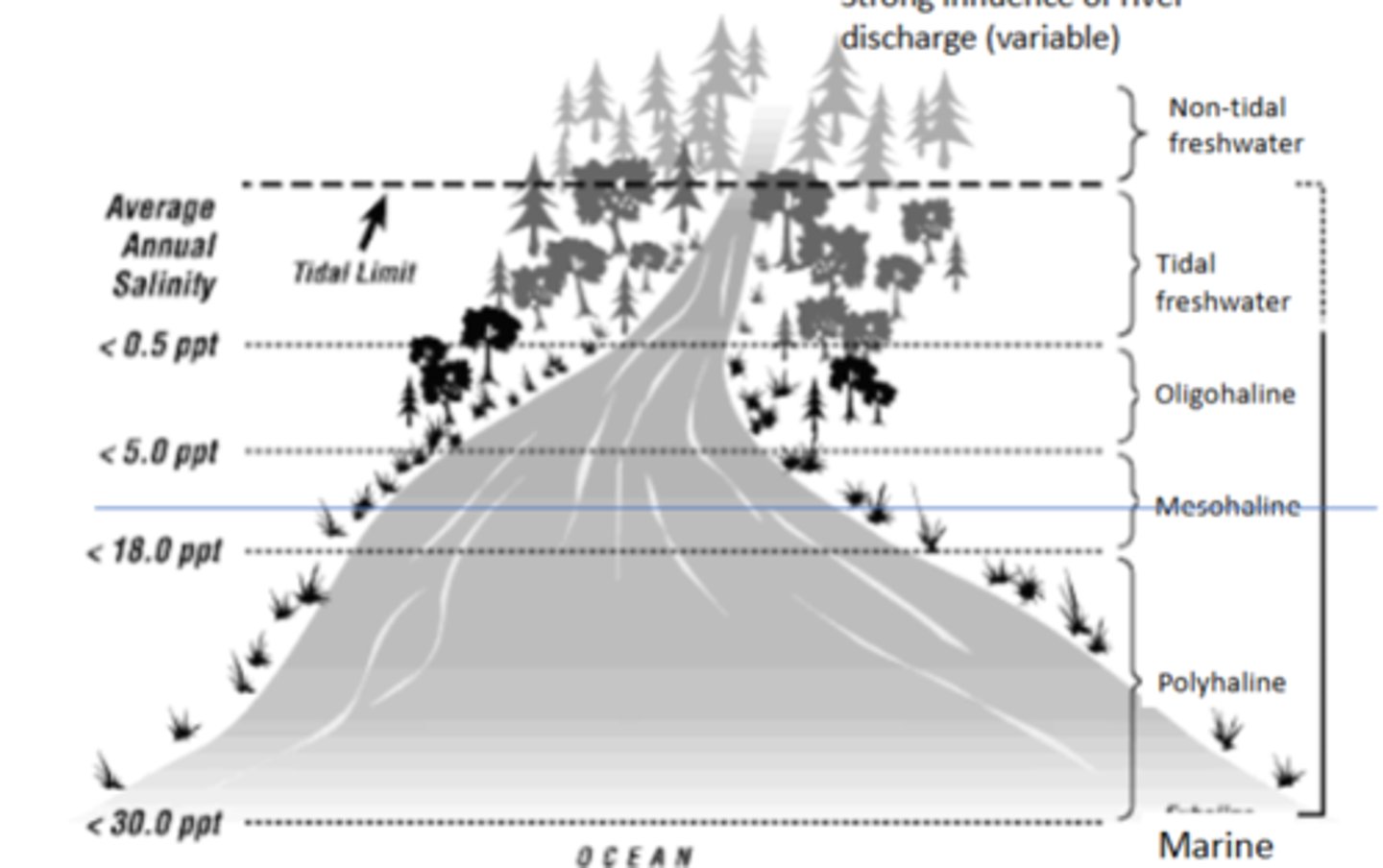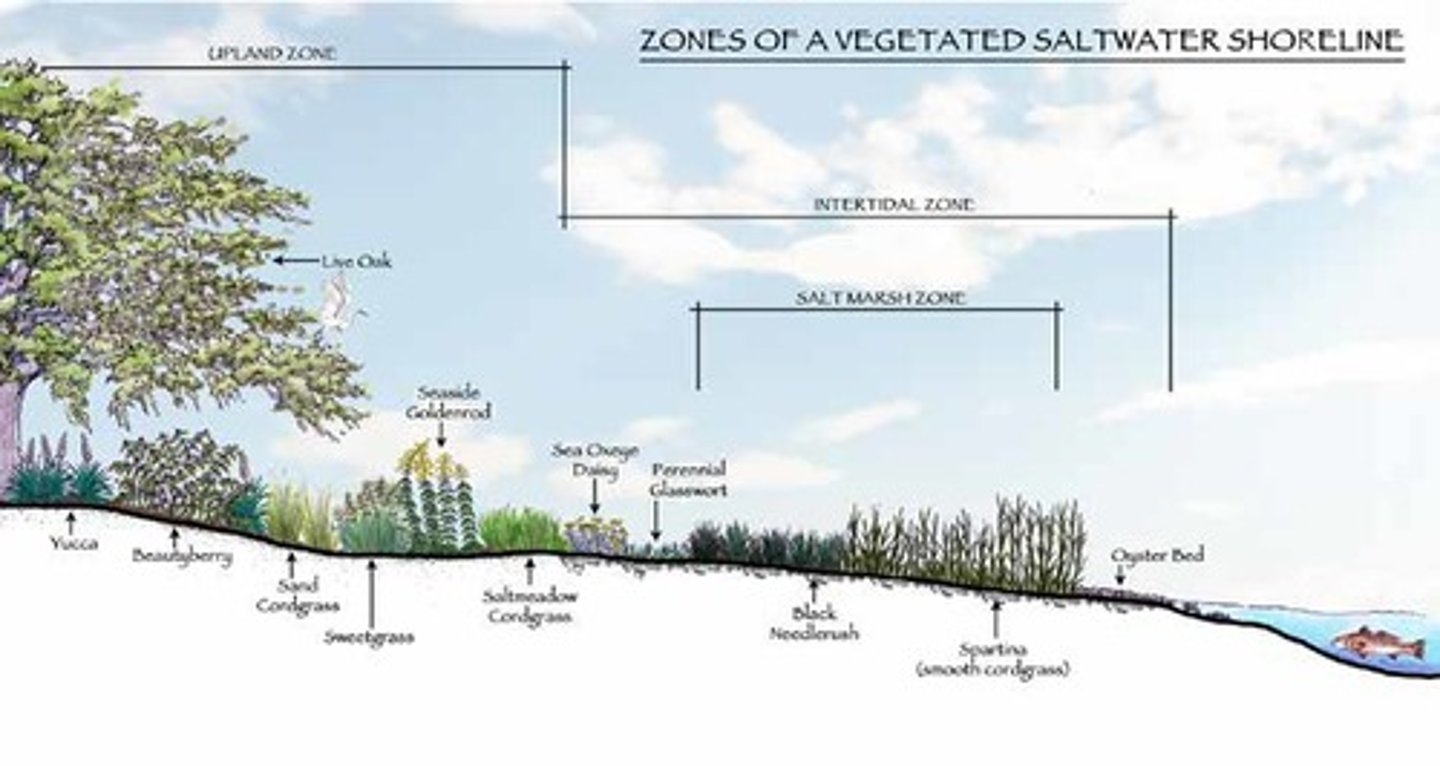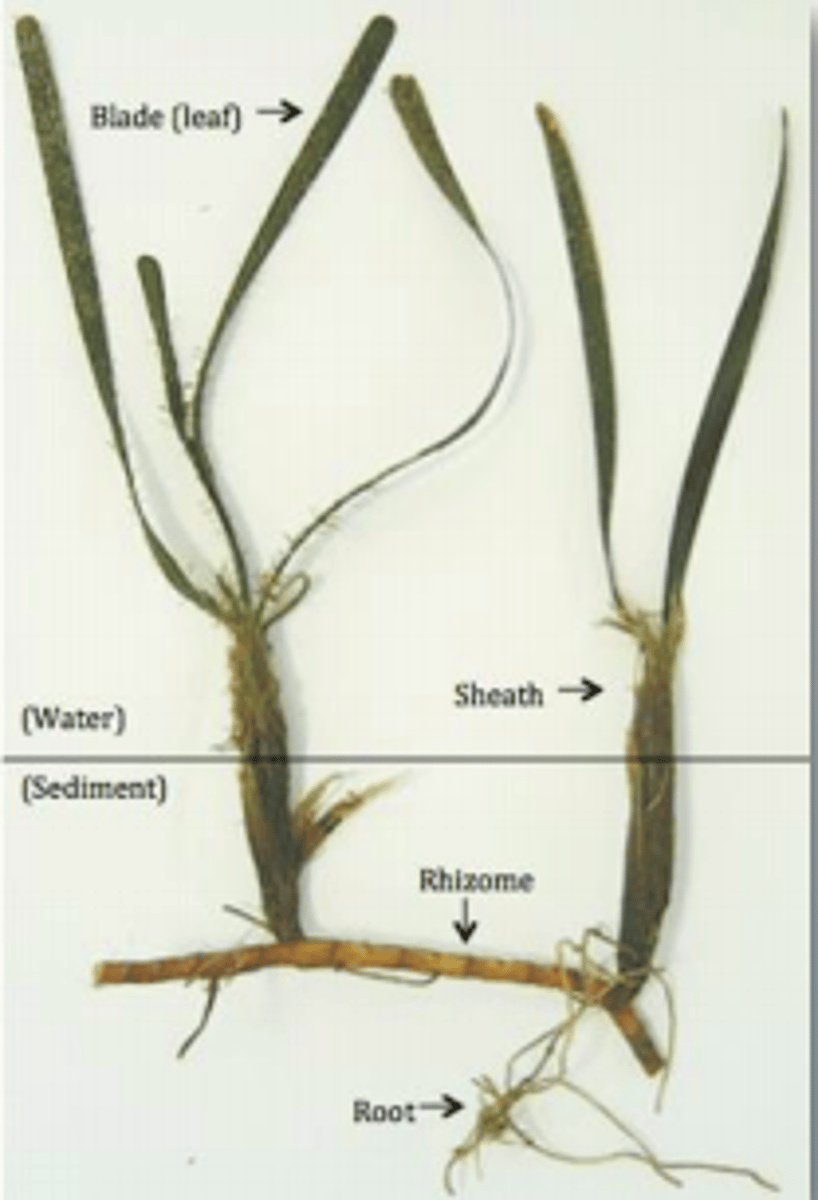2- estuaries and salt marsh
1/55
There's no tags or description
Looks like no tags are added yet.
Name | Mastery | Learn | Test | Matching | Spaced |
|---|
No study sessions yet.
56 Terms
estuaries
- link between freshwater and ocean
- dynamic habitats
salt marsh
tidally influenced coastal wetlands on the edges of estuaries and on protected shorelines where freshwater mixes with seawater
organisms in estuaries and salt marshes
- birds
- fish
- burrowing animals (need to be able to deal with low 02 conditions)
- plants
estuaries, bays, and lagoons
- support essential ecosystem functions
- productivity
- trophic support
- biodiversity
- nutrient filtering
- nutrient retention and recycling
salinity gradients in estuaries
salinity increases with depth

primary producers in an estuary
- green macroalgae
- cyanobacteria
- phytoplankton
- diatoms
substrate of mudflats
- typically sand and/or mud
- deposition of river sediment
- low flow allows smaller particles to settle
- decomposition of organic matter
- trapping of sediment by plants
burrowers and deposit feeders
allow for bioturbation
what do salinity gradients do?
- create diversity gradients within estuaries
- lower diversity because it's harder to be adapted to the changing conditions
salt marshes
- coastal wetlands that are flooded and drained by saltwater brought in by the tides
- waterlogged, root-filled, and very spongy sediments
- frequently submerged by the tides
- oxygen levels in sediments can be extremely low (hypoxia)
- accretionary environments: trap sediment and create land
salt marsh zonation
1. salinity tolerance
2. submergence tolerance
3. tolerance of anoxic sediments

mud/sand
- low rugosity
- sediment remains suspended
marsh grass
- increases rugosity and turbulent flow
- sediment falls out of suspension as water slows
mudflats
- low-lying areas o fthe marsh are often covered with large, flat expanses of mud
- fine silts and clays
- burrowing animals (clams, mussels, oysters, fiddler crabs, worms)
salinity varies across tides
- during low tide, salinity drops as freshwater runs over mud flat
- during high tide, salinity rises as freshwater floats on salt water
oxygen
water column
- depends on mixing
- most well mixed, O2 throughout column
- anoxic bottom water (deep jords, eutrophies estuaries)
sediments
- sediments become oxygen depleted with sediment depth
- burrows, roots can bring oxygen into sediments
how does spartina cope with submergence and anoxia?
- roots need O2 to metabolize
- aerenchyma tissue has air spaces that allows spartina to exchange gases, even when surrounded by anoxic soil
marine/coastal plants
- mostly grow in soft bottom habitats
- habitat formers/foundation species
- vascular tissue
- angiosperms (seeds and flowers)
- secondarily marine
- polyphyletic groupings
foundation species
- habitat structure
- trophic support
- ecological services/function
ecological importance of seagrasses
- foundation of the community as a primary producer
- Seagrasses are the base of a food web that supports manatees, sea turtles, fish, and waterflow
herbivory in tropical seagrass
large herbivores (turtles, manatees, dugons) promote health of tropical seagrass
seagrass herbivores
- keep the seagrass health
- bioturbation promotes nutrient cycling
- eating older pieces of seagrass prevents disease
mangroves as foundation species
- modify soil, water flow, nutrients, and light
- provide habitat for variety of animals and algae
- canopy, roots, mud
- in general, high biodiversity
plant-animal interactions not well understood
- generalist pollinators
- dispersed by water
- fruits generally not attractive to animals
- low herbivory by large animals, but extensive herbivory by variety of crabs
Cassiopea sp.
the ubside-down jelly with algal endosymbionts
vascular plants/angiosperms
- undergo sexual reproduction through flowers and pollination
- Seagrasses also undergo asexual reproduction through rhizomes
seagrass anatomy

seagrass morphology
- can look superficially similar to algae
- main difference is that seagrasses have roots
seagrass reproduction
asexual
- seagrass rhizomes can fragment, disperse, and create new patches of seagrass
sexual
- flowers- less common, but do produce flowers and seeds
- important after severe disturbances
pollination
- mangroves are mostly animal-pollinated
- not usually dependent on specific pollinator
vivipary
- reproduction and growth while still attached to plant
- flowering
- fertilization
- propagule growth
- unusual in angiosperms, but is found in non-mangrove groups
- vivipary is reproduction via embryos. embryo lacks a physical dormancy stage and stays attached to parent plant as germinates
- cost: put a lot of energy into something very visible to herbivores
propagule dispersal
-Maturity-Drop off from maternal plant
-Either float and disperse or drop to the mud
-Float vertically with appropriate environmental conditions
-Dispersal depends on tides, predation, water currents, and canopy cover
tropical seagrasses
- many, many species
- in the Indo-Pacific as many as 14 species can be found growing together
- in contrast to relatively monospecific meadows in temperate regions
biogeography of mangroves

why are seagrasses only in shallow marine habitats?
they need light for growth
five adaptations of seagrasses to survive in the estuarine/marine environment niche
- grow while completely submereged
- adapted to survive high/varying salinity
- anchor system to withstand moving water
- submarine pollination mechanism
- able to compete with other marine spp.
water/light
- seagrass can only survive in coastal areas where light penetration is high
- seagrass depth distribution depends on light penetration and turbidity
- seagrass morphologies are adapted to different environments
mangrove zonation
- often discrete zones of different mangrove species
- zonation mainly related to tides but it's a complex environment
- tidal sorting hypothesis
- interspecific competition
- frequency dependence of seed predators
- tolerance to different soil conditions
mangrove submergence
- mangrove roots encounter saturated saline and anoxic soils, making water and nutrient extraction difficult
- many species have converged on elaborate root systems to deal with environmental stress
- "aerial root" a root that is exposed to the atmosphere at least part of the day
salinity
- salinity affects seagrass distribution, growth rate and resistance to disease
- some seagrasses can survive salinities as low as 20 ppt and as high as 74 ppt
dealing with salt
- halophytes are plants adapted to high salinity
- to grow successfully in salt water, plants havve to acquire water and avoid excess salt
ways to deal with salt
1. osmo-regulation: increase salt or other solute concentration in tissue
2. exclusion: exclude salt at root surface or exclude from sensitive organs (all mangroves exclude salt at roots, some up to 99%)
3. shedding: plant parts like leaves senesce and take salt build up with them
4. succulence: increase the amount of water per unit area to dilute internal salt concentration and lessen effects
5. secretion: salty solution secreted on plant surface, then remove by rain, tides, or wind (salt glands evolved in several mangrove families separately)
air exposure
most seagrasses are intolerant of desiccation, but there are exceptions
substrate
- seagrasses are adapted to different substrates (sand, mud, rubble, rocks, silt, or combinations of these)
- the geology and rate of erosion of a coastline influences the benthic substrate composition
- therefore, geology influences distribution of seagrass
other ecological importance of seagrasses
- seagrass extend the boundary layer
- the canopy of a seagrass creates drag and slows water as it passes over and/or through the bed
- suspended particles then fall out of the slower moving water (accretion)
- organic accumulation and exportation
- seagrass beds are net exporters of organic materials that support beaches, estuaries, and offshore productivity
- nursery for many marine species
- seagrass beds are a 3D structure that serve as nurseries for both offshore fish and fish that transition to/from the mangrove and coral reef ecosystems
ecosystem services provided by mangrove ecosystems
- nursery ground for fish and invertebrates
- shoreline stabilization
- wind, wave, and storm protection
- nutrient retention
- filter sediments and pollutants
- flood mitigation
- carbon sequestration
- protection of associated marine ecosystems
goods and services of seagrasses and mangroves
- commercial and artisanal fisheries
- water purification
- stabilize sediments
- food and material source
human-use of mangroves
- firewood and timber: several species are high density, termite, and marine border resistant
- tannins and dyes: high tannin concentration expecially in rhizophoraceae; mangrove sap source of black dye in polynesian tapa cloth
- food
- charcoal
- medicine
mangroves at risk
- cleared for aquaculture, urbanization, or coastal landfill
- deteriorate due to indirect effets (pollution or upstream land use)
- rising sea levels
invasive mangroves
good: stabilize shoreline, mitigate runoff, nursery ground for small fish
bad: encorach on existing wetland habitat, clog canals and streams, damage historical fishponds, altering coastal ecosystems
ugly: accumulate trash, stagnant water, no beach access
disturbances in seagrass beds
- temporary change in average conditions
- additive
- anthropogenic
- antagonistic
loss of seagrasses
- seagrass wasting disease
- eutrophication
negative impacts of macroalgal abundance
1. ulva sp. abundance decreased shoot density of seagrasses
2. ulva sp. abundance decreased epiphyte load on seagrass= negative trophic effect
invasive species
pioneer seagrass out-competes native seagrasses
climate change
- more CO2
- more erosion
- increased respiration
feedback loops
- a cycle of increased nutrients
- a cycle of overfishing